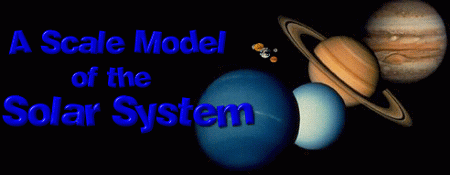 Our solar system is huge, and it's mostly empty space. This makes it difficult to visualize. It is impossible to draw a diagram of the solar system to scale. If you draw the planets so you can see them, you need a sheet of paper hundreds of metres long. If you draw the size of the orbits to scale on ordinary paper, most of the planets are so small they're invisible. Here's a method you can use to demonstrate in a very visual and dramatic fashion how big our solar system really is. You will have to do it outside, where there is a large field or playground. You'll need a few helpers, a 50 m measuring tape, and if you want to include Pluto, (which in 2006 was deemed to be no longer a planet), you'll have to send someone about 1.3 km down the road. The sun is the centre of our system. It is a star, and the source of all our energy. We're going to represent it with a basketball. Place the sun on the ground. The planet Mercury is the planet nearest the sun, and as a result, it's very hot. It's also very small. You will need a grain of sand to represent Mercury; place it on the ground 13 metres from the basketball sun. Next comes Venus, which is about the size of the earth. Use an apple seed, and place it 25 metres from the sun. The Earth is another apple seed, and you must place it 34 metres from the basketball. This is how far the earth is from the sun, on our scale. Further out from the sun is Mars. It's a little smaller than Earth, so use a small apple seed this time. Place Mars about 52 metres from the sun. Next is Jupiter, the largest planet. Scientists believe it is almost hot enough inside to shine like a star, but not quite. It's a big ball of gas which we're going to represent by a golf ball, and place at the huge distance of 180 metres from the sun. You may notice the large gap that occurs between Mars and Jupiter. It is believed that a planet would have formed at that location, but the disturbance of nearby Jupiter's gravity prevented a planet from forming there. Amazingly, the pieces of the unformed planet can be seen, ... as asteroids. The next planet from the sun is Saturn, and it's a smaller version of Jupiter, but with spectacular rings. (Actually, all the planets have rings; Saturn's are the only ones that are easily visible.) Saturn will be represented by a ping-pong ball, and it is located at a distance of 320 metres from the basketball sun. Futher out is Uranus (pronounced 'yer-run-us'), which we will show as an ordinary marble, at the distance of 650 metres from the sun. Next comes Neptune, which we will represent by another marble. It is located 1000 metres, or 1 km, from the sun. O.K., now for Pluto. This tiny dwarf planet's orbit ... we're going to use a small appleseed again ... is very elliptical, and every few hundred years it actually loops in closer to the sun than Neptune. But its average distance from the sun is about 1300 metres, or 1.3 km. So there you have it ... the solar system laid out for you to see, to scale (although you may have to squint a little to see Pluto way off in the distance...). You may be wondering how far you'll have to go to place a second basketball, to represent the nearest star to our sun. Well, you'll need to send it by mail because on this scale, the nearest object, not counting comets, is the star system Alpha Centauri, which is a whopping 8000 kilometres away! Is there a way to represent interstellar distances like this that we can visualize? Well, sort of. But we'll have to throw away the basketball model; in fact, to do it, we'll need to represent the entire solar system you've just laid out over a distance of 1.3 km by the head of a pin. This reduces our scale by a factor of something like 1,300,000. So stick the pin in the ground. Its head represents our entire solar system out to Pluto. All of the planets and the sun, inside the head of the pin, would be way too tiny to see. The nearest star is 4.3 light years away. That represents the distance that light can travel in 4.3 years. Since light moves VERY fast ... about 300,000 km every second ... it covers a lot of distance in 4.3 years. The nearest star is at a distance of 40,000,000,000,000 kilometres (that's 40 trillion!). You'll need another pin. It's location? About 6 metres away. That's how much empty space there is between stars. Pinheads representing solar systems, scattered at distances of many metres. Entire galaxies of stars can collide and pass through each other, with few direct collisions between stars. This distance (to the nearest star, Alpha Centauri), is so immense that our fastest spacecraft would take almost 100,000 years to travel there. |